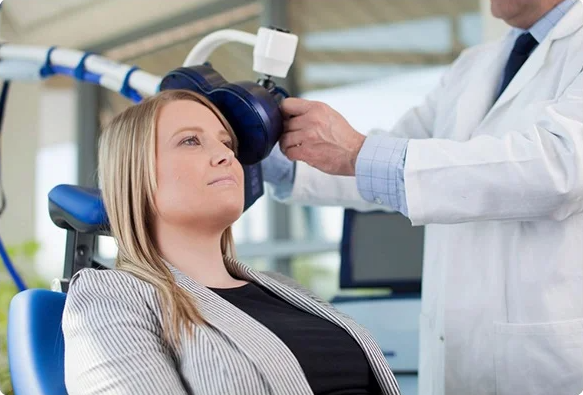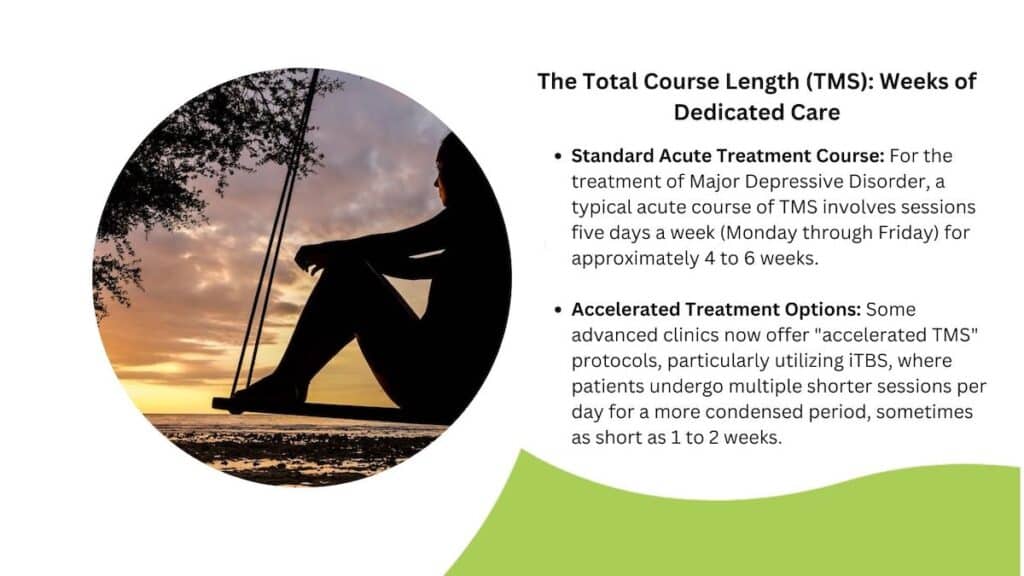
If you’re considering Transcranial Magnetic Stimulation (TMS) therapy for depression or other mental health conditions, one of the most common questions is, “How long does it actually last?” This question has a few different answers, as “length” can refer to the duration of each individual session, the total number of sessions in a typical course, and most importantly, how long the beneficial effects of the treatment are expected to last for your well-being.
Understanding these aspects can help you plan for treatment and set realistic expectations for your journey towards healing.
The Duration of Each Individual TMS Session
The time you’ll spend in the clinic for each TMS session has evolved significantly with advancements in technology and treatment protocols.
- Traditional rTMS (Repetitive TMS): In the past, a standard session using repetitive TMS protocols might have taken around 37 minutes. This involved precisely timed magnetic pulses delivered to specific areas of the brain.
- Accelerated Protocols (e.g., iTBS): Newer, more efficient protocols, such as Intermittent Theta-Burst Stimulation (iTBS), have revolutionized session length. These protocols deliver magnetic pulses in rapid, shorter bursts, allowing for significantly condensed treatment times. An iTBS session can be remarkably short, often lasting as little as 3 to 10 minutes. This efficiency can be a major advantage for individuals with busy schedules.
During a typical session, you’ll be comfortably seated in a reclined chair, awake and alert. A magnetic coil will be positioned on your scalp, and you’ll hear a clicking sound and feel a tapping sensation. Most patients find the experience tolerable, and you can often read, listen to music, or relax during the treatment.
The Total Course Length: Weeks of Dedicated Care
Beyond individual sessions, TMS therapy is administered as a complete course of treatment, typically involving daily sessions over several weeks.
- Standard Acute Treatment Course: For the treatment of Major Depressive Disorder, a typical acute course of TMS involves sessions five days a week (Monday through Friday) for approximately 4 to 6 weeks. This translates to a total of around 20 to 30 sessions, though some protocols might extend slightly longer based on individual response. The goal of this acute phase is to achieve significant symptom reduction or remission.
- Accelerated Treatment Options: Some advanced clinics now offer “accelerated TMS” protocols, particularly utilizing iTBS, where patients undergo multiple shorter sessions per day for a more condensed period, sometimes as short as 1 to 2 weeks. While requiring a more intensive daily commitment, these programs can be beneficial for those seeking faster symptom improvement or who have logistical challenges with prolonged daily visits.
The exact number of sessions and the overall duration of your course will be meticulously determined by your prescribing doctor or psychiatrist. They will consider your specific diagnosis, the severity of your symptoms, your response to the treatment, and any co-occurring conditions to create a personalized treatment plan designed for optimal outcomes.
How Long Do the Benefits of TMS Last? Sustaining Your Well-being
This is perhaps the most important “length” question for many considering TMS: how enduring are the effects? While TMS is not a permanent “cure” for depression, its benefits can be remarkably long-lasting for a significant number of individuals.
Initial Improvement to Sustained Relief: Many patients begin to experience noticeable improvements in mood, energy, and overall well-being within the first few weeks of treatment. More substantial and consistent relief typically occurs towards the completion of the full acute course. Studies and clinical experience indicate that a large percentage of patients who respond to TMS maintain their improvement for several months to over a year after completing the initial treatment.
Preventing Relapse: Research, including long-term follow-up studies, suggests that the antidepressant effects of TMS can be durable. For some individuals, particularly those with a history of recurrent depression, maintenance or “booster” TMS sessions may be recommended. These are typically much less frequent (e.g., once a week, every few weeks, or monthly) and shorter in duration than the initial acute phase, designed to help prevent symptom relapse and sustain the positive outcomes.
Retreatment Effectiveness: If symptoms do eventually return after a period of relief, a full course of TMS can often be successfully repeated. Many patients who responded well to their initial course experience similar positive results upon retreatment, reinforcing TMS as a viable long-term strategy for managing chronic depression.
The goal of TMS therapy extends beyond just immediate symptom reduction; it aims to provide significant, lasting relief, empowering you to regain control over your life and improve your overall quality of living. Your progress will be continuously monitored by your healthcare provider to ensure the best possible long-term outcome for your mental health.

FAQs About How Long TMS Treatment Lasts
Does a shorter TMS session (like 3 minutes) mean it’s less effective? No, newer accelerated protocols like iTBS are backed by research showing they can be just as effective as longer, traditional sessions, but they deliver the magnetic pulses in a more efficient pattern.
If I start to feel better early in treatment, can I stop sooner? It’s crucial to complete the full recommended course of treatment, even if you start feeling better. Stopping early can increase the risk of relapse and reduce the long-term effectiveness of the therapy.
What happens after the initial 4-6 week course of TMS? After the acute course, your doctor will assess your progress. Some individuals may continue with regular therapy or medication, while others might transition to maintenance TMS sessions if recommended, or simply continue to monitor their symptoms.
Is TMS a permanent cure for depression? No, TMS is not considered a permanent “cure” in the sense that it eliminates the possibility of future depressive episodes. However, it can provide significant and long-lasting remission of symptoms for many individuals.
How long do the benefits last without maintenance sessions? The duration of benefits without maintenance sessions varies widely. Studies show a significant number of responders maintain relief for 6-12 months, and often longer, but individual results differ.
If my symptoms return after a year, can I get TMS again? Yes, TMS can be safely and effectively repeated if symptoms return after a period of remission. Many patients find success with retreatment.
Does insurance cover maintenance TMS sessions? Insurance coverage for maintenance TMS sessions can vary significantly and is often less widely covered than the initial acute treatment phase. It’s important to check with your specific insurance provider.
Schedule Your Complimentary TMS Screening Today
At My TMS Therapy, we’re here to help you restore your energy and joy. Our compassionate team will guide you through every step of the process.
Call us at (877) 548-8081 or contact us online to book your screening today.
Sources:
Mayo Clinic. (2022, November 29). Transcranial magnetic stimulation (TMS). https://www.mayoclinic.org/tests-procedures/transcranial-magnetic-stimulation/about/pac-20384625
Brain & Behavior Research Foundation. (2019, June 18). How Long Do the Benefits of TMS Last? https://bbrfoundation.org/content/what-transcranial-magnetic-stimulation-tms-treatment-and-how-well-does-it-work
PubMed Central. (2020, December 1). Transcranial Magnetic Stimulation for Depression: A Review of Clinical Efficacy and Safety. https://www.ncbi.nlm.nih.gov/pmc/articles/PMC7770857/


